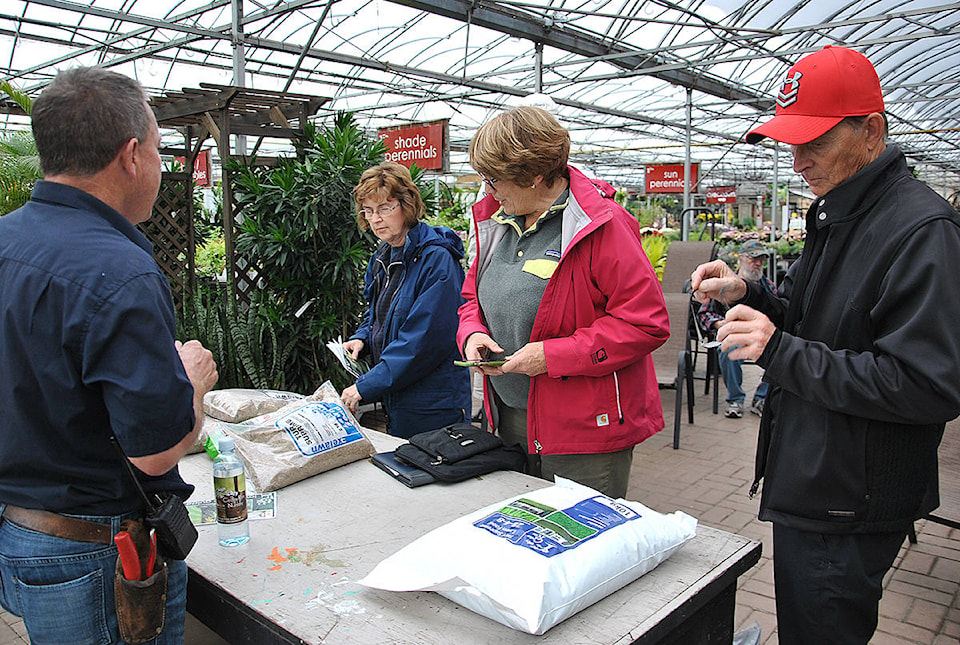There’s DIY for gardeners, although not much is heard about it – it’s just assumed.
Well more and more landscape and yard maintenance companies continue to pop up around the Lower Mainland, there are still many gardeners who are anxious to take care of their yards and gardens themselves.
And a series of free seminars – about everything from roses, mason bees, and green gardening, to make-and-take workshops on moss hanging baskets, edible container gardening, and perennial planting – are offered at nurseries around Langley.
Cedar Rim Nursery, for instance, is one of several garden centres in and around Langley offering educational sessions. Others include Art’s Nursery in Port Kells, Milner Village Garden Centre, and Port Kells Nurseries.
Cedar Rim owner Russ Bruce (left) leads some of the seminars, including this one on lawn care.
Among his tips:
1. Aerate and de-thatch: You will know if your lawn is in need of aeration if you have a significant amount of moss. Moss growth is a good indication that water is sitting on the surface of the soil. If you have a large amount of dead grass in your lawn, you may wish to de-thatch your lawn. This will allow air and sun to penetrate for a nice thick lawn. You can rent an aerator or de-tatcher from your local rental company or have a landscaper do this for you.
2. Apply moss killer: If you have moss, apply moss killer one week after liming. It is easier to use the ‘ready to use’ moss killer, which simply attaches to your hose, allowing you to water the moss killer into your lawn. For best results, be sure to apply this on a warm, dry day. The outdoor temperature should reach at least 15 degrees Celsius for at least four hours after application.
3. Apply lime: Apply lime at the rate of one 50-pound bag of Dolo-Pril per 4,000 square feet. Dolo-Pril is almost dustless and adds both calcium and magnesium to the soil. Lime will help raise the pH, allowing better uptake of nutrient by your lawn. This way, all of your fertilizer will be able to be absorbed by the grass.
4. Rake: Lightly rake the moss once it turns brown and dries up, if it is thick. If the moss is quite think, then you can leave it in place. Never rake off green moss as the live spores will spread and your second crop of moss will be much stronger than the first.
5. Top dress: It is always a good idea to top dress with sand after aerating. After removing any dead, brown moss, you can top dress the lawn with clean, washed sand, which is great for filling in low spots and will aid in drainage.
6. Over seeding: Late February, March, and April are great times to over seed the lawn. Choose a blend that is right for your area. Use shady lawn seed, which is a shade-tolerant grass for shady areas. Choose a locally blended mix as most national blends have blue grass, which does not do well in our wet coast environment.
7. Grass length: When mowing your lawn, you should cut no more than the top 25 per cent of the grass blade. Cutting length can vary depending on the season. In summertime, the ideal length is three inches, whereas in winter, it should be two to two-and-a-half inches high.
8. Fertilize: Starting in February, use a slow release high nitrogen fertilizer every four to six weeks throughout the growing season for a consistent green lawn. Use a mix such as 28-4-8 or similar. Slow release fertilizers will not burn your lawn.
He also has tips to offer about seasonal pests, and is happy to talk with customers about their specific issues.
Cedar Rim is also preparing for its Easter Eggstravaganza at the end of the month, when kids plant an Easter basket while they wait for a visit with the Easter bunny.
